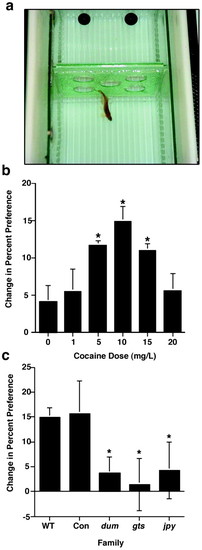- Title
-
Behavioral screening for cocaine sensitivity in mutagenized zebrafish
- Authors
- Darland, T. and Dowling, J.E.
- Source
- Full text @ Proc. Natl. Acad. Sci. USA
|
Cocaine-induced CPP in zebrafish. (a) An example of a test subject and apparatus used in these experiments. The response to cocaine is a decided shift in preference for the side of the apparatus in which the fish were exposed to cocaine. (b) This response was dose dependent with a maximal effect at 10 mg/liter. Values are averages of means from multiple experiments conducted at each dose (six families at 0 and 10 mg/liter, three families at the other doses, and a minimum of five fish tested per family). Values at 5, 10, and 15 were significantly higher than both untreated and lidocaine controls (*P < 0.05 by ANOVA). (c) F3 generation fish derived from mutagenized F2 families that showed lower conditioned place preference. Con was a control family derived from normal responders of the same family that produced dum. The F3 families dum, gts, and jpy all show lower cocaine-induced place preference than both wild-type families and the control family (*, P < 0.05 for each compared with wild-type untreated control fish by ANOVA). Error bars represent ± SEM. |

